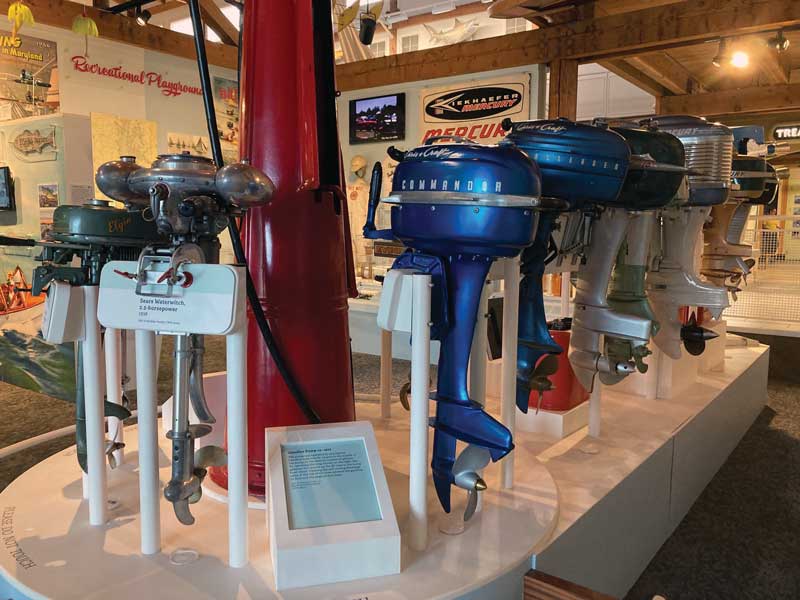If you’re one of those Chesapeake Bay boaters already looking ahead to spring, you’ll want to mark your calendar with the Solomons Maritime Festival on Saturday, May 6. It’s a special, one-day event hosted by the Calvert Marine Museum that celebrates old engines, outboards, raceboats, and raceboat drivers—all on display with free admission.

Here you can explore how the unique combination of classic boats, natural history, and maritime heritage tell the story of the Chesapeake Bay. Before we get deep into all this history, let’s talk about the museum’s newest masterpiece. Her name is Witchcraft.
She was the terror of Lake Champlain competitions from 1903 to 1920 where she was raced by her original owner, William Bowditch Rogers. The next owner added an engine and competed in races around the Long Island Sound until the 1940s and then sold her to Ken and Dorothy Saffer. They sailed her to Baltimore, MD, in the early part of the 1940s.
Witchcraft has been on the Chesapeake Bay since then. She’s a grand lady and a great addition to the museum’s collection of boats that have contributed to the Chesapeake’s sailing tradition. Dave Butler Jr. purchased her in 2008. He enjoyed the boat for years and did a full restoration. Donated in 2022, you’ll now find this beauty in her slip dockside under the Drum Point Lighthouse at the Calvert Marine Museum.

Built in 1903 by the well-known George Lawley & Son Boat Yard in Boston, Rogers launched her as Witchcraft II, a racing yacht. She eventually made her way down to the Chesapeake Bay on a treacherous journey during World War II. In 1970, a 30-year restoration project was started to amend for all those years of sailing the Chesapeake. In 2007, Butler reconnected with Witchcraft after searching for her design plans. Butler and his brother, Bryan, had enjoyed spending summers on the Chesapeake sailing with their father and were elated to find that she still existed.
Butler has shown her at the Annapolis Boat Show as well as in the June 2022 Antique and Classic Boat Festival in St. Michaels. This magnificent sailing yacht always draws a crowd.
While you’re at the museum, you’ll also want to check out “Oystering in the Late 19th Century.” Local packinghouses processed and moved oysters from Bay to table and across the country. Most workers started early in the morning and worked as much as 12 hours a day, six days a week. The packinghouse was also a source of community and opportunity where shuckers were paid based on their productivity.

In the Discovery Room you can search for real fossils that range between eight to 20 million years old. The maritime gallery travels the Patuxent River through time, starting with the “Pawtuxunt” Indians during the time when they came in contact with Captain John Smith. Here you’ll learn more about the English settlers during the colonial period who grew tobacco and shipped it from the Patuxent River’s wharves to British ports.
Located next to the Small Craft Building and adjacent to the boat basin, the Patuxent Small Craft Center serves as the headquarters for the small craft program. Here, volunteers of the Patuxent Small Craft Guild share insights about the museum’s fleet of historic boats and preserve the art and skills of wooden boat building. Boat building classes are held year-round for those interested in building a traditional wooden boat.
The Paleontology Gallery displays fossils from the Miocene epoch. That block of earth’s history lasted from about 23 to 5.3 million years ago.
Last but not least, you can’t miss the Drum Point Lighthouse. This screwpile, cottage-type light is only one of three remaining from the original group of 45 that once served the Chesapeake Bay at the beginning of the 20th Century. After it was decommissioned in 1962, the lighthouse fell victim to vandals. Volunteer researchers worked on gathering information about the history of this historic lighthouse. In 1975 this rare lighthouse was rescued, giving it permanent placement at the Calvert Marine Museum. Today it’s beautifully restored with appropriate period furnishings and is recognized as this waterfront’s main attraction.
Be sure to plan for a chock-full day on May 6! For more information on the Solomons Maritime Festival, visit the Calvert Marine Museum's website.
By Chris "Seabuddy" Brown